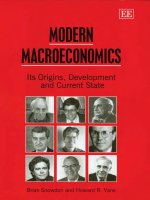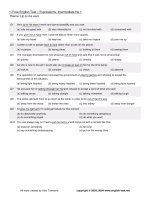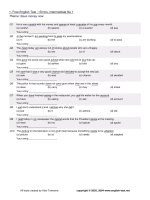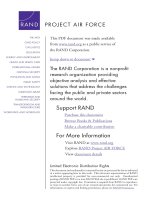Intermediate macroeconomics chapt16
Bạn đang xem bản rút gọn của tài liệu. Xem và tải ngay bản đầy đủ của tài liệu tại đây (327.91 KB, 22 trang )
Chapter 16: Consumption
John M. Keynes: Absolute Income Hypothesis
Consumption is a linear function of disposable
personal income,
C = C + cY
C = consumption expenditure
Y = disposable income
C = autonomous consumption (intercept of the line)
c = marginal propensity to consume (slope of the line)
Properties of Consumption Function
Consumption is determined by current income
Marginal propensity to consume (MPC = ΔC/ΔY) is
between zero and one (0
income rises
Short-run Consumption Function
Consumption expenditure
C = C + cY
Constant APC
c
C
Disposable income
Empirical Evidence
High income families have a higher marginal propensity
to save (MPS = 1 – MPC)
High income families have a higher average propensity to
save (APS = 1 – APC); APC falls with the level of income
In the long-run, autonomous consumption falls to zero
(C = 0)
Long-run Consumption Function
Consumption expenditure
C = ćY
Variable APC;
Ĉ=0
ć
Ĉ
Disposable income
Irving Fisher: Intertemporal Choice
Consumption decisions are based on current and future
income
Current period income = current income plus present
value of future income: Y1 + Y2 / (1 + r), where r is a
discount rate
Future period income = future income plus future value
of current income: Y2 + (1 + r)Y1
The Intertemporal Budget Line
Future Period
B
C2
A
Y2
C2
C1
Y1
C1
C
Current Period
The Intertemporal Budget Line
Along BC, there is a trade-off between current and
future consumption spending
Along AB, C1<Y1, but C2>Y2: consumers would save in
current period to finance consumption in second period
Along AC, C1>Y1, but C2
Consumer Preferences
Consumer preferences are shown by a family of
indifference curves
Any combination of current and future consumption
along an indifference curve provides the same level of
satisfaction for the consumer
A higher indifference curve yields combinations with
greater satisfaction
Consumer Preferences
Future Period
Combination B is preferred to
combination A because it yields
more in both periods
B
A
Current Period
The Consumer’s Optimum
Consumer equilibrium is achieved at the tangency of
the highest attainable indifference curve and the
budget line
The tangency determines the optimum allocation of
consumption spending in both periods; i.e. highest
level of satisfaction within the budget
The Consumer’s Optimum
Future Period
Higher income shifts the budget
line up, positioning the consumer
on a higher indifference curve and
consumer’s optimum
C2f
C1f
B
A
C1c
C2c
Current Period
Franco Modigliani: Life Cycle Hypothesis
Consumption depends on income and wealth
C = Consumption expenditure
W = Consumer wealth
R = Length of productive life time
T = Years of life
Consumption Function
C = (W + RY)/T = (1/T)W + (R/T)Y
Define:
α = 1/T is the MPC out of wealth
β = R/T is the MPC out of income
C = αW + βY
Consumption Function
Consumption expenditure
1
C = αW + βY
β
αW
Disposable income
For the United States, α = 0.02 and β = 0.60.
Consumption Function
Consumption expenditure
αW2
αW1
Disposable income
Increased wealth shifts the consumption function upward.
Consumer Behavior over Life Time
Consumption spending is a stable function of income
Consumers save their leftover income
Consumers accumulate wealth during the productive
lifetime
Consumer finance retirement by dissaving and sellingoff their assets
Consumer Behavior over Life Time
$
Wealth
Income
Saving
Consumption
Dissaving
R
T
Years
Milton Friedman: Permanent Income Hypothesis
Measured income consists of permanent and
transitory income; Y = YP + YT
Permanent income is the average income we make
during years of productive life
Transitory income is the random variation from the
average
Consumption Function
Consumption is a function of permanent income
C = αYP
Consumers use saving and borrowing to smooth
consumption in response to transitory changes in
income
Determinants of Consumption
Combining all the theories, we can conclude that
consumption depends on
Current income
Expected future income
Wealth
Interest rate









